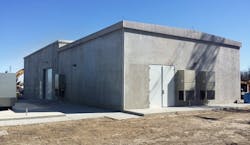Saving Time & Money With Precast Concrete Buildings
When the timeframe for its project was too short for traditional construction methods to meet, the San Jacinto River Authority (SJRA) turned to a precast concrete building solution for its pump station installation in Baytown, Texas.
The new transfer pump station was needed because the Chevron-constructed facility in Baytown required more water for its operations. The new station has to pull 16.5 mgd from the Coastal Water Authority canal and pump it into the SJRA canal.
The Solution
The original specification was for a large concrete masonry unit (CMU) building. Houston contractor Boyer Inc. was the low bidder on the project, but its bid was still over budget. Through SJRA-initiated value engineering, Boyer offered an Easi-Span precast concrete building as an alternative after determining a CMU could not be constructed in time or on budget.
Nathan Davis, a project manager for Boyer, says the building was an easy aspect to quantify.
“There were not only savings on the front end for cost of the structure, but there were savings on the back end with the reduced time from pouring the slab to setting the roof panels that allowed Boyer to reduce overall construction time, labor and equipment costs for the project,” he said.
Easi-Span buildings utilize clear-span precast concrete roof sections from 20 ft to 50 ft in width. Each 10-ft-deep roof section is post-tensioned to adjoining sections, allowing for buildings of virtually unlimited length to be manufactured.
Two Easi-Span buildings – 40 ft by 40 ft by 16 ft and 30 ft by 60 ft by 20 ft – were needed to house all the pump station equipment. The buildings were manufactured and installed by Lonestar Prestress Manufacturing Inc. of Houston. Lonestar, a licensed producer for Easi-Set Buildings, works directly with customers to meet individual needs and ensure quality standards are met.
“Boyer was able to propose the use of the precast concrete buildings as a value engineering solution because it has worked with SJRA in the past and knew the building owner’s project goals,” said Leo Rowe, sales manager for Lonestar. “We were able to add our experience and expertise to Boyer’s ingenuity to meet the project schedule and budget.”
The Results
The Easi-Span buildings allowed Boyer to finish the main slab and begin installing critical electrical gear in less than two weeks.
“This included prepping and pouring the slab, installing walls, setting roofs and caulking the walls and roof panels,” Davis said. “The offsite fabrication of the wall and roof panels was timed so that once the slab was poured and cured, we could set the panels.”
If the owner had stayed with the original CMU design, Davis believes it most likely would have taken at least three months before the critical work for the pump station could have started.
The interconnected buildings have different functions and customizations. The 30-ft-by-60-ft area houses two large pumps with an additional section for a future pump. The building was customized with two large roll-up doors and three large roof hatches so the pumps can be removed and replaced as needed in the future. The 40-ft-by-40-ft building houses two rooms for electrical equipment.
